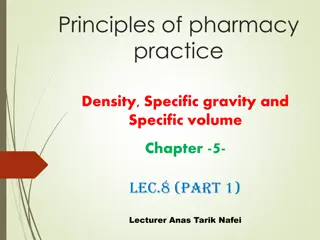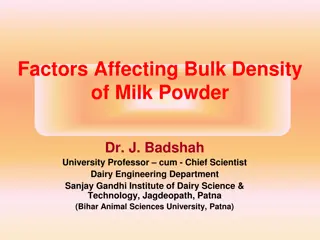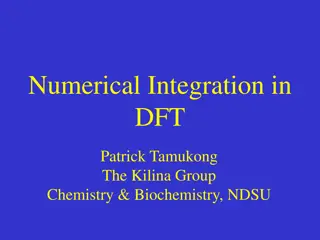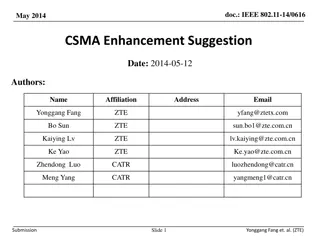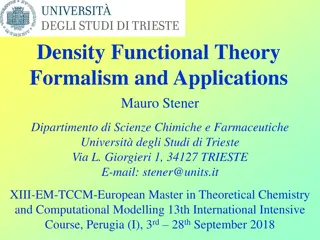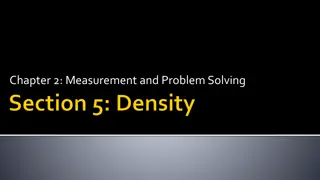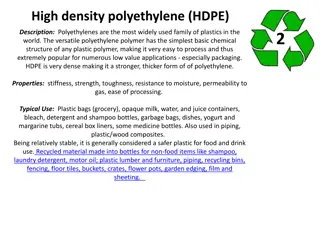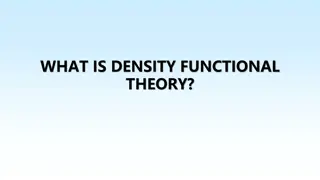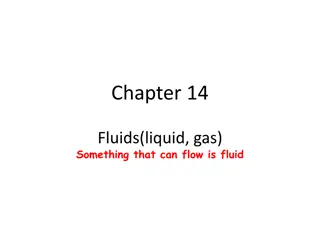Understanding Density Functional Theory in Chemistry
Density Functional Theory (DFT) plays a crucial role in chemistry by uniquely determining molecular properties based on electron density. The Hohenberg-Kohn Theorem establishes the foundation, with the goal of finding an exact energy functional expressed in terms of density. Various concepts like the Thomas-Fermi theory, Kohn-Sham DFT, and the use of orbitals are discussed in relation to determining kinetic and exchange-correlation potentials. Ultimately, DFT provides insight into electronic structures without relying on wave functions.
Download Presentation

Please find below an Image/Link to download the presentation.
The content on the website is provided AS IS for your information and personal use only. It may not be sold, licensed, or shared on other websites without obtaining consent from the author. Download presentation by click this link. If you encounter any issues during the download, it is possible that the publisher has removed the file from their server.
E N D
Presentation Transcript
Chem Chem 580: DFT 580: DFT
Density Functional Theory Density Functional Theory (Chapter 6, Jensen) (Chapter 6, Jensen) Hohenberg-Kohn Theorem (Phys. Rev., 136,B864 (1964)): For molecules with a non degenerate ground state, the ground state molecular energy and all other electronic properties are uniquely determined by the ground state density 0. Appealing since density depends on 3 coordinates whereas wave function depends on 3N coordinates. Problem: Don t know the density. So, HK theorem is an existence theorem. Also, need to know the density at every point in 3N-dimensional space. Functional: Function of a function. E[ 0(x,y,z)]
Density functional theory Density functional theory Goal of DFT development: Find exact energy functional that expresses the ground state energy in terms of the density: E=E[ (x,y,z)] = + + = + + + E T V V T V J K ne ee ne T=kinetic energy, Vne=el-nuc attraction, J=Coulomb, K=exchange In the limit of the exact density, J[ ] and K[ ] implicitly include electron correlation. Vne [ ]and J[ ] are treated normally: ( ) r Z = V dV A ne r r A ( ) ( ') r r r = J dV '
Density functional theory Density functional theory ne ee T V V + + = = + + + E T V J K ne Question: How do we determine T[ ] and K[ ]? In QM, T is differential operator; K depends on orbitals Thomas-Fermi theory (Physics): Provides T[ ] of a uniform, non- interacting electron gas. Can solve exactly Spherical cow Problem: Does not work for chemistry since chemical bonds don t exist in this model. = 5/3 ( ) r dr T C 3 ( ) 3/2 = 2 3 C TF F F 10 3 3 4 = 4/3 ( ) r dr K C 1/3 = C Dirac TF X X
Density functional theory Density functional theory Kohn & Sham (KS) proposed using orbitals to construct functional. (Phys. Rev., 140, A1133 (1965)). Similar to HF independent particle model Assume non-interacting electrons. The Hamiltonian of the reference system is: 1 2 n = h = + 2 i KS i ( ) r v KS i H h s i s = 1 i This gives us starting orbitals like 1st step in HF Now add in repulsions: = + ( ) + H T V V ext ee = no repulsion: independent particle model = repulsion term Vee depends on orbitals; Vext=Vne SCF similar to HF
Kohn Kohn- -Sham (KS) DFT Sham (KS) DFT What is the wave function for the reference system ( =0)? Independent particle model: Must be a Slater determinant! = 1... ,0 1 s N N The molecular orbitals iare called Kohn-Sham orbitals with orbital energies i Note: orbitals, NOT density DFT is not supposed to have a wave function!
KS Density functional theory KS Density functional theory The exact kinetic energy functional for the reference system is: 1 2 T = 2 i s i i i For interacting electrons, this is only an approximation (similar to HF). Since the density is still not known, Kohn-Sham calculates the density as: = 2 = ( ) r ( ) r ( ) r Same as for HF s i i = + + + Then, we have: E T V J E DFT S Ne xc Exc contains exchange and correlation corrections. Exchange is the largest part Usually highly parametrized
KS Density functional theory KS Density functional theory Major problem and effort is to find a reasonable expression for Exc[ ]. The KS procedure: (1) (1) = KS (1) h i i i ( ) r 1 2 Z r + + = 2 1 r (1) (1) (1) 2 d v A 2 xc i i i 12 r A 1 A Solved iteratively as in HF The exchange-correlation potential vxc is given by: ( ) r r E = xc ( ) r v xc ( )
KS Density functional theory KS Density functional theory There are MANY choices of exchange-correlation functionals. One approach, so far not broadly successful, is to use very high level of ab initio theory to get density, then use it to determine Exc[ ]. This approach is difficult to generalize. Most common to separate into two independent parts: xc x E E = + E c Jacob s ladder: Unoccupied orbitals Generalized RPA (Random Phase Approximation) Hybrid Add HF Exact exchange , 2 , And/or Meta-GGA , GGA LDA All levels build upon LDA as the base: House of cards All levels build upon LDA as the base: House of cards Lowest rung is unreliable Lowest rung is unreliable
Local density approximation (LDA): The local density can be treated as a uniform electron gas. Basically Thomas-Fermi Theory (spherical cow) xc xc E ( ) ( ) xc x = ( ) ( ) + = LDA r ( ) r d c Cx 1/3 3 3 4 ( ) ( ) ( ) r 1/3 x = Early variant was X method devised by Slater where correlation is ignored. The exchange part: 3 2 ( ) ( ) ( ) r 1/3 = C is a parameter (usually 0.75) x x
LDA LDA Correlation functional calculated ad hoc, often determined using Monte Carlo methods and then fitted to analytic formula. The two most common correlation functionals: Vosko-Wilk-Nusair (VWN): Can. J. Phys,58,1200 (1980) Perdew-Wang: Phys. Chem Rev. B, 45,13244(1994) Both formulas given in Jensen. Lots of fitted parameters. 1) 2) LDA tends to overestimate binding energies, does not describe hydrogen bonds properly.
Gradient corrected methods: Generalized gradient approximation (GGA): Non-uniform electron gas. Both exchange and correlation energies dependent on the gradient of the density. These functionals are sometimes called non-local: Wrong since they depend on the density at a point in space (unlike HF exchange). Exchange part: Best seems to be PW91 (Phys. Rev. B, 46,6671 (1992)) Formula in Jensen, lots of parameters. Built on LDA Correlation part: Most popular by Lee, Yang, Parr (LYP). Contains 4 parameters determined by fitting to data on He atom. (Phys. Rev. B, 37, 785 (1988). Note: LYP provides no correlation for parallel spins.
Meta-GGA: Include either (or both) the second derivative of the density or the orbital kinetic energy density. 1 2 2 = KS i i Most popular functionals: TPSS, B95, M06-L Most popular new functionals are meta-GGAs. Most promising are set of M06 functionals from Truhlar group, but seem to need a different one for different problems. One size does not fit all.
Hybrid functionals: Mix LDA, GGA (or meta-GGA) and exact HF exchange: Called exact exchange Becke proposed (JCP, 98, 5648(1993)): = + b E + + c E + 3 88 B xc LDA x exact x B x LDA c GGA c (1 ) E a E aE E a, b, c are empirically fitted parameters: Semi-empirical! Built on LDA If we use the LYP correlation functional, we get B3LYP. Parameters a, b and c fitted to reproduce the G2 test set. Method Mean absolute deviation (kcal/mol) Maximum Absolute deviation (kcal/mol) G2 1.6 (Composite) 8.2 G2(MP2) 2.0 (Composite 10.1 G2(MP2, SVP) 1.9 (Composite) 12.5 B3LYP 3.1 (Hybrid) 20.1 B3PW91 3.5 (GGA) 21.8 SVWN 90.9 (LDA) 228.7
Hybrid functionals: Different hybrid functionals use different amounts of exact exchange . Works reasonably well for organic molecules Different hybrids work often better for different properties. Often better barrier heights than HF or GGA. Not as good as MP2/RI-MP2 Built on a house of cards Starting point is LDA Better approach is to build DFT on 2-electron functions P.M.W. Gill W. Kutzelnigg
Advantages and disadvantages of DFT Advantages and disadvantages of DFT DFT in GAMESS: $CONTRL DFTTYP= $END and $DFT Can be run with SCFTYP= RHF, UHF, ROHF Numerical grids, cannot integrate analytically: Can make grid denser (better) or sparser using: NRAD= (Number of radial points, default=96) NTHE= (Number of angle theta grids, default=12) NPHI= (Number of angle phi grids, default=24, must be twice NTHE) Larger values= finer grid Can actually avoid grid by using resolution of the identity to simplify integrals. RI based on: . i x y = x y j i m m j m Exact if { m}= complete basis. Can develop auxiliary basis set for this purpose. First suggested by Almlof, implemented by Glaesemann & Gordon. J. Chem. Phys., 112, 10738 (2000).
Advantages and disadvantages of DFT Advantages and disadvantages of DFT Summary of scaling: N7 CCSD(T) N5 MP2 eN Full CI eN MRCI N4 DFT N4 HF DFT and HF cost can be reduced by manipulating long-range: Make linear scaling at very long distances using multipolar expansion or localized orbitals Very demanding methods can be reduced in scaling using localized orbitals: reduces range of interaction. Semi-empirical methods ~ N2-N3: N grows less quickly. Bottleneck is matrix diagonalization. Formal linear scaling method: MM
Advantages and disadvantages of Advantages and disadvantages of DFT DFT Some problems: Weak interactions due to dispersion. For instance, no bonding between two He atoms. Solution: Add dispersion ad hoc (Grimme) Self-interaction error: Density of a single electron interacts with itself. Leads to underestimation of band gaps. Some functionals try to correct for self-interaction. Poor charge transfer predictions. Very bad for metal oxides Ground state theory (need TDDFT for excited states) Poor for conical iontersections Not systematically improvable HF MP2-CCSD(T)-CCSDT-CCSDTQ CIS-CISD-CISDT Nothing comparable for DFT
Further Information http://www.phy.mtu.edu/pandey/talks/trickey_dft-course_2008-07.pdf






